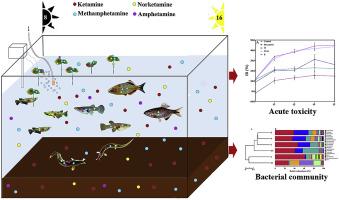当前位置:
X-MOL 学术
›
Water Res.
›
论文详情
Our official English website, www.x-mol.net, welcomes your feedback! (Note: you will need to create a separate account there.)
Environmental behavior of methamphetamine and ketamine in aquatic ecosystem: Degradation, bioaccumulation, distribution, and associated shift in toxicity and bacterial community.
Water Research ( IF 12.8 ) Pub Date : 2020-02-04 , DOI: 10.1016/j.watres.2020.115585 Zhenglu Wang 1 , Sheng Han 2 , Min Cai 3 , Peng Du 4 , Zhaobin Zhang 2 , Xiqing Li 2
Water Research ( IF 12.8 ) Pub Date : 2020-02-04 , DOI: 10.1016/j.watres.2020.115585 Zhenglu Wang 1 , Sheng Han 2 , Min Cai 3 , Peng Du 4 , Zhaobin Zhang 2 , Xiqing Li 2
Affiliation

|
Ketamine (KET) and methamphetamine (METH) have been recognized as emerging contaminants in aquatic ecosystems. This paper aimed to investigate the environmental behaviour, including the degradation, distribution, and bioaccumulation, of METH, KET, and their main metabolites (amphetamine (AMP) and norketamine (NorKET)). The changes in acute toxicity in the aqueous phase and in the bacterial community in sediment were determined to assess the associated eco-risk of the drug exposure. Five types of lab-scale aquatic ecosystems were established and exposed to KET or METH for 40 days: a water- sediment- organisms- KET system (K), a water- sediment- organisms- METH system (M), a water- sediment- organism- METH- KET system (M + K), a water-sediment- KET- METH system (control), and a water- sediment- organisms system (biocontrol). The results demonstrated that much faster degradation occurred for both METH (t1/2 = 3.89 and 2.37 days in the M and M + K group, respectively) and KET(t1/2 = 5.69 days 5.39 days in the K group and M + K group, respectively) than in the control group (t1/2 = 7.83 and 86.71days for METH and KET, respectively). Rapid adsorption of KET, METH, and their metabolites was observed in the sediment, which had clay and silt as the main particle sizes. KET was observed to be absorbed by shallow-water fish (Chinese medaka, rosy bitterling and mosquito fish), while METH was dominantly ingested by bottom-dwellers (loach). Duckweed might play a crucial role in the dissipation process of METH and KET, which were mainly adsorbed by duckweed roots. During incubation, the acute toxic levels in the K and M + K groups changed from non-toxic to medium toxicity levels, and the toxicity in the M and control groups changed from non-toxic to low toxicity levels. Moreover, marked changes in the bacterial community in the sediment induced by METH or KET exposure were observed, and the most significant change in the bacterial community was observed in the group spiked with both METH and KET. This work for the first time elucidated the environmental behaviors of METH and KET in aquatic ecosystem and associated the impact on ecological system equilibrium.
中文翻译:

甲基苯丙胺和氯胺酮在水生生态系统中的环境行为:降解,生物积累,分布以及相关的毒性和细菌群落转移。
氯胺酮(KET)和甲基苯丙胺(METH)被公认为是水生生态系统中的新兴污染物。本文旨在研究甲基苯丙氨酸甲酯,KET及其主要代谢产物(苯丙胺(AMP)和去甲胺(NorKET))的环境行为,包括降解,分布和生物富集。确定了水相和沉积物中细菌群落的急性毒性变化,以评估药物暴露的相关生态风险。建立了五种实验室规模的水生生态系统,并将其暴露于KET或METH达40天:水-沉积物-生物-KET系统(K),水-沉积物-生物-METH系统(M),水-沉积物-生物体-METH- KET系统(M + K),水沉积物-KET- METH系统(对照)和水-沉积物-生物体系统(biocontrol)。结果表明,METH(M和M + K组分别为t1 / 2 = 3.89天和2.37天)和KET(K组和M + K组分别为t1 / 2 = 5.69天5.39天和5.39天)发生了更快的降解。与对照组相比(分别为METH和KET的t1 / 2 = 7.83天和86.71天)。在沉积物中观察到了KET,METH及其代谢产物的快速吸附,沉积物中以粘土和淤泥为主要粒径。据观察,KET被浅水鱼(中式,玫瑰色苦味鱼和蚊子鱼)吸收,而甲基苯丙胺则主要被底层居民(泥ach)吸收。浮萍可能在METH和KET的消散过程中起关键作用,这些过程主要由浮萍的根部吸收。在孵育过程中,K和M + K组的急性毒性水平从无毒变为中等毒性,M组和对照组的毒性从无毒变为低毒。此外,观察到由METH或KET暴露引起的沉积物中细菌群落的显着变化,并且在掺入METH和KET的组中观察到细菌群落的最显着变化。这项工作首次阐明了甲基丙烯酸甲酯(METH)和KET在水生生态系统中的环境行为,以及对生态系统平衡的影响。
更新日期:2020-02-04
中文翻译:

甲基苯丙胺和氯胺酮在水生生态系统中的环境行为:降解,生物积累,分布以及相关的毒性和细菌群落转移。
氯胺酮(KET)和甲基苯丙胺(METH)被公认为是水生生态系统中的新兴污染物。本文旨在研究甲基苯丙氨酸甲酯,KET及其主要代谢产物(苯丙胺(AMP)和去甲胺(NorKET))的环境行为,包括降解,分布和生物富集。确定了水相和沉积物中细菌群落的急性毒性变化,以评估药物暴露的相关生态风险。建立了五种实验室规模的水生生态系统,并将其暴露于KET或METH达40天:水-沉积物-生物-KET系统(K),水-沉积物-生物-METH系统(M),水-沉积物-生物体-METH- KET系统(M + K),水沉积物-KET- METH系统(对照)和水-沉积物-生物体系统(biocontrol)。结果表明,METH(M和M + K组分别为t1 / 2 = 3.89天和2.37天)和KET(K组和M + K组分别为t1 / 2 = 5.69天5.39天和5.39天)发生了更快的降解。与对照组相比(分别为METH和KET的t1 / 2 = 7.83天和86.71天)。在沉积物中观察到了KET,METH及其代谢产物的快速吸附,沉积物中以粘土和淤泥为主要粒径。据观察,KET被浅水鱼(中式,玫瑰色苦味鱼和蚊子鱼)吸收,而甲基苯丙胺则主要被底层居民(泥ach)吸收。浮萍可能在METH和KET的消散过程中起关键作用,这些过程主要由浮萍的根部吸收。在孵育过程中,K和M + K组的急性毒性水平从无毒变为中等毒性,M组和对照组的毒性从无毒变为低毒。此外,观察到由METH或KET暴露引起的沉积物中细菌群落的显着变化,并且在掺入METH和KET的组中观察到细菌群落的最显着变化。这项工作首次阐明了甲基丙烯酸甲酯(METH)和KET在水生生态系统中的环境行为,以及对生态系统平衡的影响。


























 京公网安备 11010802027423号
京公网安备 11010802027423号